Facebook has become synonymous with affordable marketing. Its array of business-friendly tools and immense audience are a marketers’ dream. But, like any marketing tool, it’s how you use it that matters most.
In this in-depth guide, we’ll explain how to harness the power of Facebook organically (for free) and we’ll teach you how to become a successful Facebook marketer.
If this is your first foray into Facebook marketing, work your way through the guide from top to bottom. If this isn’t your first Facebook rodeo, skip straight to the sections that interest you most.
Why market on Facebook?
Marketing and Facebook go together like tacos and Tuesdays — it’s almost always going to be a good idea. Facebook is a well-oiled marketing machine, and as such, setting up your brand’s presence and running campaigns is a relatively straightforward affair. If the massive built-in audience isn’t enough to draw you in, the comprehensive (and free!) business-specific offerings might be what does it.
Make connections that count
Facebook wants to help connect users with businesses they’re interested in and, in turn, those businesses with interested users. It’s a win/win/win for everyone. Users secure a valuable and meaningful experience on Facebook, brands reach existing and new customers, and Facebook continues to rake in the coins.
To break the ‘why’ of it down, let’s turn to the ever-trusty stats:
Facebook attracts 1.82 billion users every single day
With the average user spending 37 minutes per day on Facebook
Making Facebook one of the world’s most popular websites
Because of that, 87.1% of marketers turned to Facebook marketing in 2020
- And 80.4% of social referrals to online stores are from Facebook
That’s a lot of users, spending a lot of time in the one place, ready to connect with your brand.
The Facebook algorithm
The infamous, the elusive, the all-powerful algorithm. The truth is no one really knows exactly what the algorithm is looking for, and it changes all the time. Thankfully, Facebook has let us in on a few hints over the years.
What is the algorithm?
The Facebook algorithm (which is really a bunch of algorithms) decides which posts users see in their News Feeds when they open Facebook. In other words, it determines precisely how successful your marketing efforts are going to be. As you might imagine, it’s incredibly difficult to market to people who can’t see your content.
Facebook pages vs. the algorithm
It wouldn’t be a silly assumption to make that someone who clicked ‘like’ on your page would be shown all the content you share. Of course, that’s not the case. They actually see very little of it unless you’ve got the algorithm wrapped around your little finger.
Trying to ensure the people who follow your page actually see what your page is posting is a notorious struggle for Facebook pages, and it’s only getting more difficult with every algorithm update. In 2020, the average organic reach for a post is only 5.5% of the page’s followers.
Say you have 5000 Facebook followers; that’s only 275 people seeing your new post.
You’re probably catching on to why knowing a thing or two about what the algorithm wants might come in handy.
How does the algorithm work (and what does it want)?
In a move towards more transparency on the platform, Facebook has somewhat recently handed more control over to the users themselves regarding what kind of content they want to see. In doing so, they’ve also made an effort to explain why users see what they see on their News Feeds.
According to Facebook, the most important factors that influence News Feed rankings are:
-
How often a user interacts with a group or page
-
The type of post users most often interact with (photo, video, link, etc.)
-
The number of comments, likes, reactions, and shares the post gets (the popularity of the post)
- How recently the content was posted
The algorithm is essentially going to reward those who:
-
Build a loyal, engaged, and active audience by posting quality content their audience cares about, and often.
-
Post a lot of videos. Ideally, high-quality videos that play for longer than 3 minutes.
-
Create content that encourages meaningful engagement (ask questions, start conversations, etc.)
- Post content when their audience is most likely to be online
How does Facebook feel about video marketing?
They’re big fans, and who can blame them? We certainly are, and you should be too.
We don’t need stats to tell you that video is infinitely more engaging than text or image content, but here’s some to impress you either way.
Facebook has over 8 billion video views per day.
Because of that, the algorithm loves video. Facebook Live and video content draw more engagement than any other post type, and the algorithm rewards its use appropriately.
Data showed video to be so engaging that a Facebook exec predicted the platform would be all video and no text by 2021.
- Which is good news since 72% of customers would rather learn about a product or brand through video.
We asked a real brand if incorporating video into their Facebook marketing strategy makes a difference.
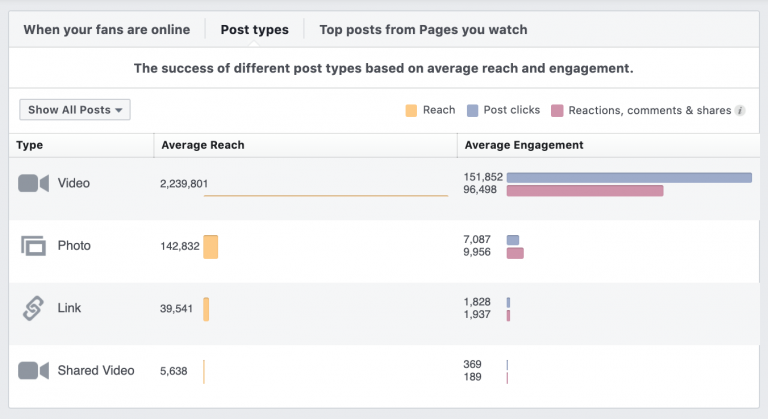
Want to start making videos for Facebook straight away? Choose from a huge-selection of easy-to-edit Facebook video templates in the Biteable template library.
Or keep reading to learn how to market your business on Facebook.
Set your goals
Before doing much else, you’ll want to establish and check in with your goals. It’s solid general life advice, but it’s also excellent Facebook marketing advice.
Connect your Facebook goals back to your broader business objectives to build results with real impact.
Start by determining where your objectives sit on the marketing funnel and narrow down your specific goals from there.
Awareness. Increase the awareness of your brand and grow your audience with content that gets your name out there. Awareness is the most common goal marketers aim to achieve on Facebook.
Consideration. Deepen and develop your relationship with your audience. Increase community engagement with content your audience finds interesting and valuable.
- Conversion. Increase sales or leads with your Facebook presence. Use content that leads to your audience taking action.
Be sure to set realistic, measurable goals with a little wiggle room to make changes around what works and what doesn’t. Identify your ideal timeline, but keep in mind organic marketing is all about taking things slow and steady — it might take a minute and a bit of effort, but growth will come.
Plan your strategy
Your strategy is your game plan. It’s what you’ll use to achieve the goals and targets you established above. With a little clever reverse engineering, you’ll be able to take your goals and objectives and figure out the marketing moves you need to get there.
Creating a strategy will also make it easier to review what is working for you and which areas require improvement.
Things to think about when writing your game plan
A few thousand Facebook likes don’t mean much if you don’t have a plan for what to do with them. Put in the time to think about your plan of action before you’re in the thick of it.
Consider:
What is a realistic tempo for your posts
What kind of content fits with your brand and your audience
How you will find your audience
What type of content (image, video, link, text, etc.) is likely to work best for you
How you will create your content (Try Biteable to make your life easier)
- How you will keep track of your posting schedule
Decide whether you want to use a dedicated social media scheduler or if you’re happy sticking to Facebook’s Creator Studio (which lets you organize and schedule posts right within Facebook).
We’d suggest starting with Creator Studio and getting a feel for what kind of social media management tools will benefit your business before making things more complicated than they need to be.
Define your audience
It’s hard to engage an audience if you don’t know who they are. Defining what your target audience looks like (who they are, where they are, what they’re interested in, etc.) will help inform every move you make.
Bring your ideal customer to life with marketing personas
Most companies acquaint themselves with their target audience by heading to the drawing board and developing a handful of customer personas. If your business is already off the ground, you’re no doubt already familiar with your ideal personas.
If not, give your ideal customer a name, an age, a profession, some interests and hobbies based on what you know about them. Then think:
What are their goals?
What is important to them?
What are their challenges?
- How could your brand make their life easier?
You can base this on existing data, an educated guess, or a healthy mix of both.
Say your product is relevant to both university students and parents of toddlers, you’ll want to make a different persona for law student, Sarah, and stay-at-home dad, John.
Both will probably respond to different content and marketing tactics, so it’s important to keep all your different personas in mind when planning your marketing strategies.
Set your sights on Facebook Audience Insights
Facebook Audience Insights gives you a peek behind the curtain at your audience’s demographics and interests. Find out exactly who your brand’s existing Facebook audience is, or use Facebook-wide Insights to learn more about potential customers.
You’ll need to set yourself up with a Facebook Business Manager account to access it. We walk you through the simple steps to creating a Business Manager account (and how to get the most out of Audience Insights) in our guide to mastering Facebook Ads.
Plan your content mix
Content is crucial. Your Facebook presence is only as good as the content you’re offering. You want it to be quality, relevant content that adds value to your target audience’s newsfeeds.
A successful Facebook page offers a thought-out mix of content that will:
-
Engage. Facebook is all about making connections and building relationships. Posting content that starts conversations humanizes your brand and increases engagement.
-
Educate. Prove why you’re a valuable page to follow with content that educates and informs. If you’re an expert in your field, use it. Share your knowledge, build trust, and establish your brand as an authority in what you do.
-
Entertain. Users aren’t opening their newsfeed hoping to be sold to; they want to be entertained. Create or curate content that is both relevant to your brand and attractive to your audience. It could be memes, trending news, funny videos, articles, or quizzes — whatever it is, show your audience you understand who they are and what they’re into.
- Promote. Keep blatant self-promo to a minimum; your audience can see straight through it. Dedicate your time to building a happy and engaged audience instead — they’ll be much more open to promotions if they trust you’re not just there to sell, sell, sell.
Suss out the competition
If you’re stuck on content ideas, a competitor analysis is a great way to find your footing and generate some inspiration.
Have a look at what your competition is doing on Facebook — what’s working for them? What isn’t working? What can you offer that differentiates yourself from them?
Once you’re up and running, Facebook lets you keep track of what your chosen competitors are up to and how your results compare with “Pages to Watch” (find it within your Page Insights overview). This will also show you which of their post types are generating the most engagement.
What kind of content floats John and Sarah’s boats?
Or whatever far more creative names you slapped on your customer personas. Consider what kind of content your target audience responds to best.
Infographics? How-tos? Memes? Detailed niche explainers?
You might have to do a little research to get to the bottom of this one, but we humbly suggest turning whatever it is into a video to multiply engagement instantly.




Count your current kudos
Don’t discount what your existing customers love about your brand. Think about what you’re offering that has caught their attention.
What has worked for your brand on other platforms? What challenges are people having that your product could help with?
If you solve a customer’s problem, show them how (an explainer video is great for this). If customers love how knowledgeable you are, turn that knowledge into valuable, share-worthy content.
When’s the best time to post on Facebook?
This is where defining your audience pays off because the answer is entirely dependent on when they’re on Facebook.
Posting content when your audience is online increases the chance of them seeing it before it’s buried in their newsfeed (if the algorithm deemed it was worthy of being there at all).
Studies typically find posting mid-week between 1 pm – 4 pm is a safe bet, but there really isn’t ONE BEST TIME for every brand and their respective audiences.
Your audience’s demographics and online behaviors are what’s going to most influence when to post. Busy full-time professionals will be online at different times to high school students or parents of newborns.
Find out when your fans are online
Because Facebook loves data, they’ve compiled a helpful graph that shows you when the people who follow your page are online. You can find this in your page’s Insights within the “Posts” tab, right at the top.
You might have to do a little bit of math since the times display in Pacific Time (PST) by default and will need to be converted to your local time zone when you schedule a post.
If you have a mostly local audience, it might look a bit like this with some pretty evident peaks and dips.
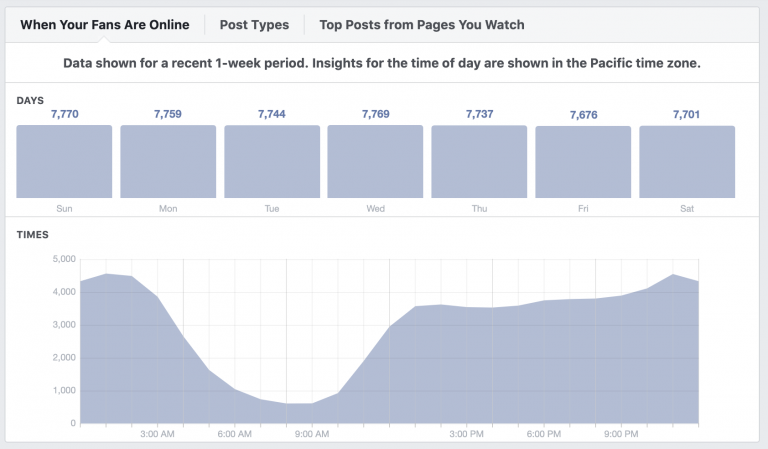
Whereas if your audience is more global, you’ll probably have a harder time seeing an obvious best time to post. It might look a little more like this (or an entirely straight line):
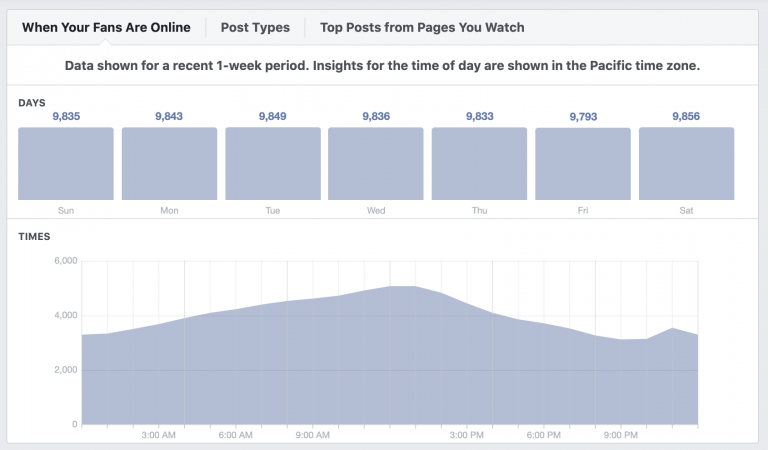
Like most things, the answer here is good old fashioned trial and error. Schedule content at different times and days to see where you find your best results — use a content calendar to keep track.
Create a content calendar
Consider getting your mitts on a content calendar to take the guessing game out of scheduling your content.
A content calendar is exactly what it sounds like: All of your content, in calendar form. It helps you:
Keep track of everything you’re posting
Remember important holidays and dates
Plan content across all your goals, objectives, and content mix
Post with consistency
- Keep your team up to date and on the same page
There are plenty of online content calendar services with varying degrees of fanciness, depending on your needs — some even post right to different platforms for you. Pick your favorite, or use something like Google Calendar or an Excel spreadsheet for a simpler (cheaper) option.
How to create a Facebook Business Page
Creating a Facebook business page requires little to no effort. This is good news because if you want to bring your business to Facebook, you’ll need one.
It’s a start-to-finish process in five simple steps:
1. Click “Create”
Hit the “Pages” button on Facebook’s left sidebar — you’ll likely have to hit “see more” and scroll down a bit to find the little orange ‘Pages’ flag. Click “Create New Page” to create your brand new business page. All you need to do is add the name of your page (aka your business), select the appropriate categories, and add a brief description to bring your page to life.
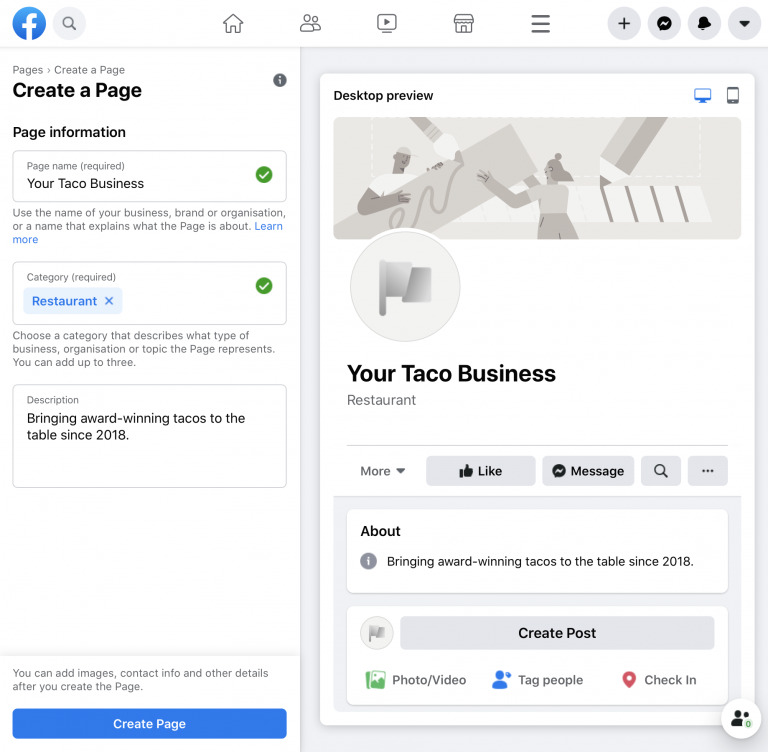
2. Bring your brand to the screen
From there, Facebook will guide you through adding a profile picture (your logo) and a cover image that represents your brand.
Because your cover imagery is the first thing page visitors see, you want to avoid cropped-off or blurry visuals. Optimize your assets to fit Facebook’s recommended dimensions — that’s 820×312 pixels for the cover photo and 170×170 pixels for your logo.
3. Get down to details
Now that your page is looking pretty, it’s time to add in the need-to-knows. This includes whichever are applicable from the following:
Your business website
Your business location info
Your business hours
- A phone number customers can contact you on
The more easy-access info you offer, the easier it will be for new customers to find you in-store or online.
4. Finish it off with a button
Make it easy for people to take action right from your page by adding a call to action button. The button appears right at the top of your page and can be for just about anything you want. The full list of page buttons is mighty comprehensive:
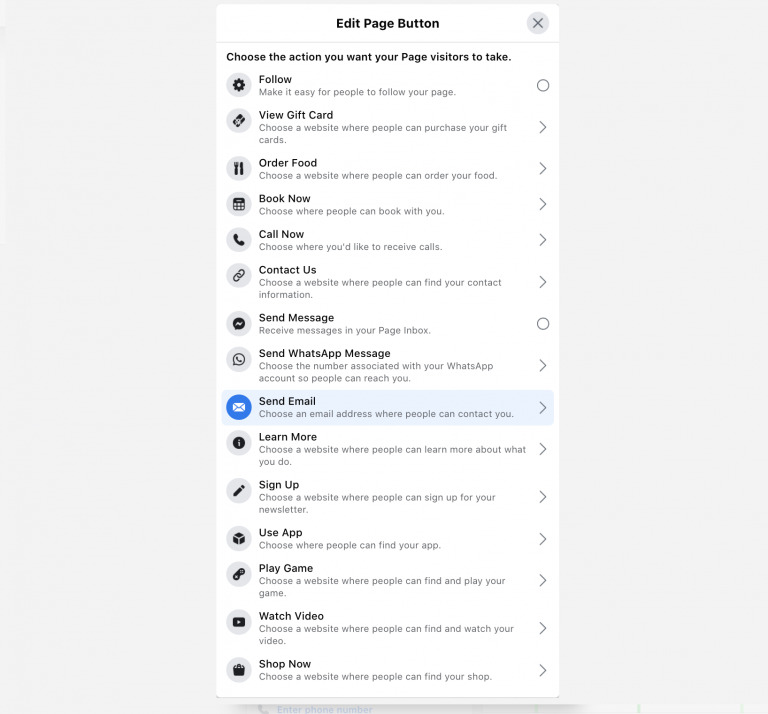
5. Make yourself easy to find
Now that your business is on Facebook, you’ll want to get the word out. Create a custom username (similar to an @ tag on Instagram or Twitter) to make it easier for people to find your page via search. Click “Create @username” right underneath your page name and select a nickname that will help your customers distinguish that it’s you.
Pages with custom nicknames also generate a bonus custom URL to avoid clunky number-ridden links.
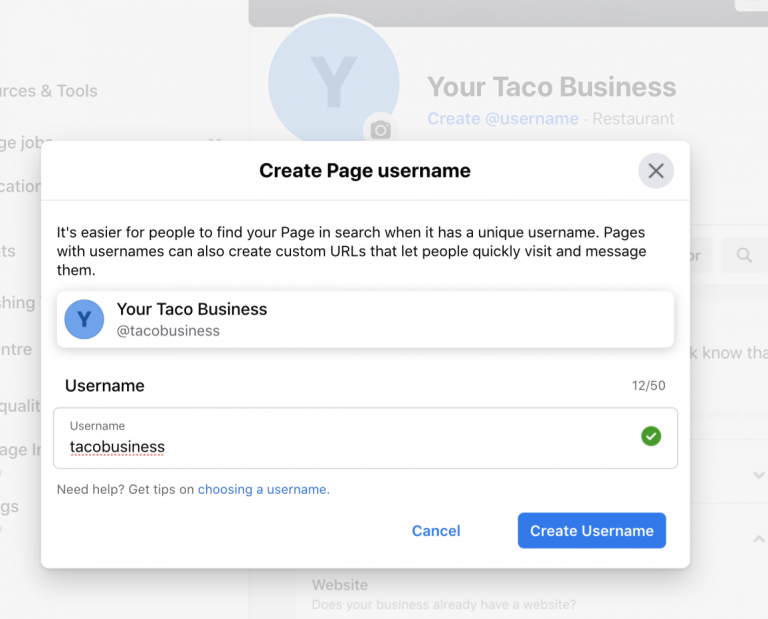
That’s all there is to it. Christen your page and welcome your future followers with a worthy first post — maybe a launch video will do the trick?
Facebook post types
You’ve got your strategy, you’ve got your content — it’s finally time to get posting. The next step is choosing which type of post you want to use to bring your content to life
Video
We’ve made our case: video is king of Facebook marketing.
Use video to create posts across your content mix, and tailor them to appeal to your target audience. Entertain, engage, educate, and promote seamlessly via video. After all, 66% of millennials have engaged with a brand after seeing a video on social media.
What Facebook is looking for in a video post
Facebook has outlined the primary factors that influence the success of video posts on its platform. These are:
Originality. The algorithm rewards original video content over reposted or shared videos from other brands or creators.
Longer videos (over 3 minutes) that get watched to the end. Facebook’s research found that their users found value in longer videos, and the algorithm is a big fan of things that provide value to users.
Loyalty and intent. If Facebook can see your audience has come to your page looking for your bangin’ video content, they’re more likely to prioritize you in the algorithm. Write clear titles and include tags on your videos so people can find them when they go looking.
- Engagement. We’ve been tooting this horn all throughout this guide, but engagement makes all the difference. Videos that spark meaningful conversation and are authentically shared are Facebook’s cup of tea.
What you need to know about posting video to Facebook
There are some more technical rules and restrictions to keep in mind when uploading a video to Facebook. The essential tips and specs to note:
Facebook accepts all the standard video file formats (though Facebook recommends MP4 and MOV).
Videos can be no bigger than 4GB (that’s larger than a full-length feature film).
Video length can be anywhere between 1 second and 240 minutes long.
Facebook allows 16:9 (horizontal), 1:1 (square), 4:5 (vertical optimized for mobile), or 9:16 (vertical) aspect ratios for newsfeed videos. Biteable recommends 1:1 or 4:5 to fill up the most space on mobile screens.
If your videos contain audio, add captions. 85% of Facebook videos are played without sound.
- It used to be the case that text had to take up less than 20% of the space in your video’s first frames and cover image. Thankfully, Facebook has now scrapped this rule.
Stories
Facebook Stories is the same concept as Instagram Stories — it’s fleeting, and it’s less formal than posts you might find on a newsfeed.
With 300 million daily Stories users and 62% of people noting they were more interested in a product after seeing it in a Facebook Story, Stories provides a wealth of potential. Better yet? Stories always sit at the top of a user’s Facebook page and remain untouched by the algorithm.
Facebook Stories work best with vertical 9:16 content to take up the whole screen.
Image
This is your pretty standard Facebook post. It might be an actual picture or a graphic, but either way, it tends to rake in more than twice the engagement of a text-only post.
Facebook recommends the square 1:1 aspect ratio for images on News Feeds.
Text
Text posts are about as basic as it gets. Just some words on a page — not much happening that’s likely to stop your audience from scrolling right on past.
Consider creating a video, image, or poll instead.
Linked content
All you need to do to generate a link is paste the URL of your linked content into your text post.
The great thing about links is they encourage clicks with minimal effort. But if the website you’re linking to doesn’t have its metadata in order, the preview image may be less than ideal. You can override this by uploading your own image into the link preview, but it can be a bit of a hassle.
Polls
Encourage engagement right on your post with a poll. There’s nothing bad to say about polls — who doesn’t love clicking on things and sharing otherwise irrelevant opinions?
Facebook Live
Facebook Lives draw insane engagement (about 4x more than other types of video posts), and so, of course, the algorithm loves them.
Lives can be trickier to pull off than other post types, primarily due to the liveness of it all. Live broadcasts require a brand spokesperson to do their thing on the fly, but it’s incredible for relationship-building and engagement if you can manage it.
Measure your performance
All your painstakingly crafted goals and objectives mean nothing if you can’t measure your strategies’ success.
The good news is that Facebook has more data and reporting tools than you will probably ever need; it’s just up to you to use them.
Facebook Page Insights
Insights provide information about your brand’s Facebook performance and the success of your posts. See what actions are being taken on your pages and posts, by who, and when.
You’ll find the “Insights” tab on the left sidebar of your page, under the “Manage Page” heading.
Insights is also where you’ll find data about when your audience is online and what kind of post types they respond to best.
If you’re not familiar with Insights, go on an exploratory mission through the many available tabs to get a feel for the kind of data on offer. The more time you spend in the daunting data-driven territory, the less intimidating it becomes.
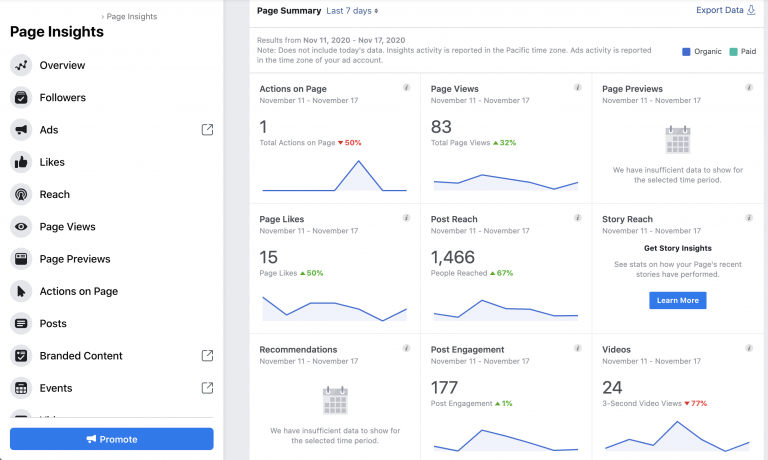
Creator Studio Insights
Facebook’s pitch for Creator Studio was to be able to do everything from one place — create, schedule, and report on your page’s posts.
Find even more insights into your page’s posts with Creator Studio Insights — including audience retention and loyalty.
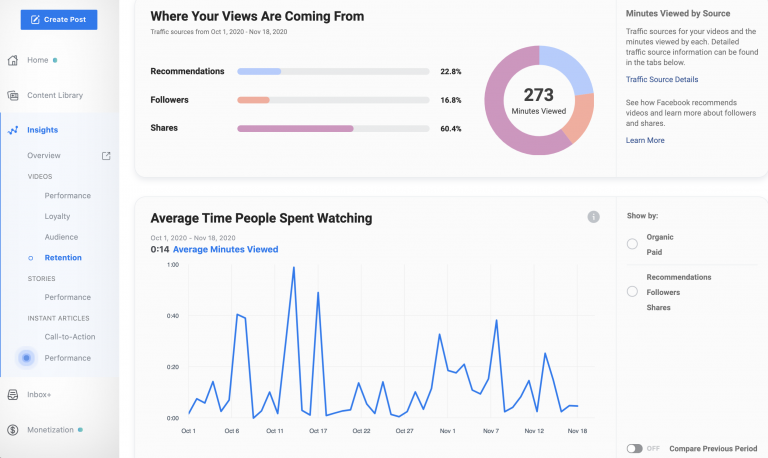
Set aside a weekly time to look over your Insights to pick up on patterns of what is working for you and what’s not. Instigate changes to your strategy as needed, then check back in on your Insights to see how the changes play out.
Facebook Groups
Create a community around your brand or the problem you solve with Facebook Groups. A whopping 1.4 billion people use Facebook Groups each month, providing the perfect opportunity for brands to connect with potential customers in more intimate spaces.
The real draw of Facebook Groups is a valuable exchange of information and an authentic sense of community — something that can be difficult to foster on a public Facebook Page.
Messenger marketing
Messenger marketing is a new and exciting method of Facebook marketing that has recently exploded onto the scene.
1.3 billion people use Messenger, and 69% of people say that being able to message a business helps them feel more confident about the brand, so it certainly isn’t an area to ignore.
Being a responsive Page to incoming Messenger messages is an excellent way to optimize your Page for both Facebook’s algorithm and meaningful customer relationships. But Messenger marketing has started going beyond that.
Messenger marketing now involves “Messenger bots,” set up by the brand, to communicate with Messenger users via AI. You can create entire conversations within a Messenger bot that guides the user through FAQs or other chosen topics, without a human interacting with the customer at all.
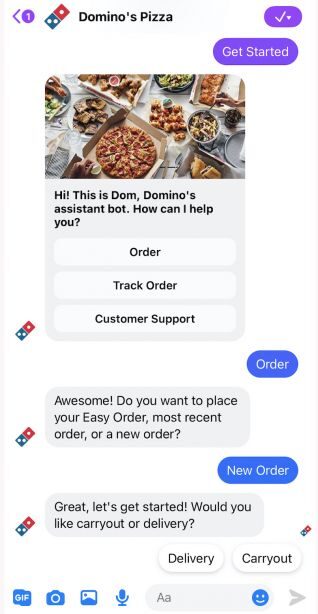
The marketing potential here is huge — brands have already started getting creative with the automated message system with incredible results. It’s still an area on the rise, but it’s something to keep an eye on.
Paid marketing: Achieving Facebook presence with a budget
If you’re in a rush (and have a budget) then you’ll do best to look beyond organic marketing to Facebook’s paid advertising tools.
Paid marketing allows you to skip past the algorithm by buying your spot at the top. Tell Facebook who, specifically, your ideal audience is, and reach every single one of them with a targeted ad.
If you’ve got a budget to back your Facebook presence, find everything you need to know about Facebook Ads in our in-depth guide to Facebook advertising.
Next step: Creating killer video content
Now that you understand the principles of Facebook marketing, it’s time to apply your new skills. Create videos for all your posts with Biteable, the world’s simplest video maker.
Start with a ready-to-edit Facebook video template or a blank canvas and craft the perfect video in no time.
Frequenty Asked Questions (FAQs)
How do I create a Facebook Business Page?
Creating a Facebook Business Page involves selecting the appropriate page type, filling in the business details, uploading profile and cover photos, and optimizing the page settings for maximum visibility and engagement.
How can I increase the engagement on my Facebook Business Page?
Increasing engagement on your Facebook Business Page can be achieved by posting high-quality and relevant content, engaging with followers through comments and messages, running interactive posts such as polls and quizzes, and leveraging Facebook Live for real-time interaction.
What are the best practices for creating engaging Facebook video ads?
To create engaging Facebook video ads, focus on capturing attention within the first few seconds, keeping videos short and to the point, using captions for sound-off viewing, incorporating a clear call-to-action, and ensuring high-quality visuals and sound.
How can I optimize my Facebook videos for better reach and engagement?
Optimizing Facebook videos involves using the correct video dimensions and formats, adding compelling thumbnails, writing engaging descriptions and titles, tagging relevant people or pages, and using Facebook’s targeting options to reach the right audience.
What types of videos perform best on Facebook?
Generally speaking, videos that perform well on Facebook tend to include how-to tutorials, behind-the-scenes content, customer testimonials, live videos, and user-generated content. These types of videos are typically more engaging and can encourage more interactions from viewers.














